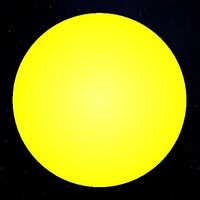mNo edit summary |
mNo edit summary |
||
| Line 8: | Line 8: | ||
|solid = No |
|solid = No |
||
|analogue = [[wikipedia:Sun|Sun]] |
|analogue = [[wikipedia:Sun|Sun]] |
||
| − | |title = SOL |
+ | |title = SOL}} |
| − | '''SOL''' is the center of [[Space Agency]] 'universe', and the only star that's accessible |
+ | '''SOL''' is the center of the [[Space Agency]] 'universe', and the only star that's accessible by spacecraft. |
Although it does not have an atmosphere, it does have a lethal [[Overheating|vaporization]] circle (5 Units above the surface) at the same area that the atmosphere would normally appear otherwise, and it will destroy parts of any type (even the solar probes) in seconds, making both [[Lander|landing]] and [[re-entry]] impossible, like [[YEL]]'s rings. |
Although it does not have an atmosphere, it does have a lethal [[Overheating|vaporization]] circle (5 Units above the surface) at the same area that the atmosphere would normally appear otherwise, and it will destroy parts of any type (even the solar probes) in seconds, making both [[Lander|landing]] and [[re-entry]] impossible, like [[YEL]]'s rings. |
||
Revision as of 06:28, 13 August 2018
 | |
|
| |
| NaviComp name | SOL |
| NaviComp coordinates |
X: 0 |
| Has atmosphere | No |
| Has solid surface | No |
| Can be landed on | No |
| Can be splashed-down on | No |
SOL is the center of the Space Agency 'universe', and the only star that's accessible by spacecraft.
Although it does not have an atmosphere, it does have a lethal vaporization circle (5 Units above the surface) at the same area that the atmosphere would normally appear otherwise, and it will destroy parts of any type (even the solar probes) in seconds, making both landing and re-entry impossible, like YEL's rings.
Its high gravity makes orbiting possible even if somewhat far away (~76 units from x=0 y=0 is the edge of the Circle Of Influence). Solar probes Alpha and Beta have been designed specifically to go into solar orbit and analyze its properties.
From SOL(+32) you can reach PUR (925) and BLU (755).
Trivia
- Unlike its real-life counterpart, SOL does not emit solar flares that can knock out spacecraft.
- The surface of SOL also lacks sunspots.
- A geometric positioning experiment performed using the NaviComps of three spacecraft indicates that SOLs calculated diameter is 32 Units, and not a radius of 8 NavCom units as was initially reported. (Photos in the comments section below)
